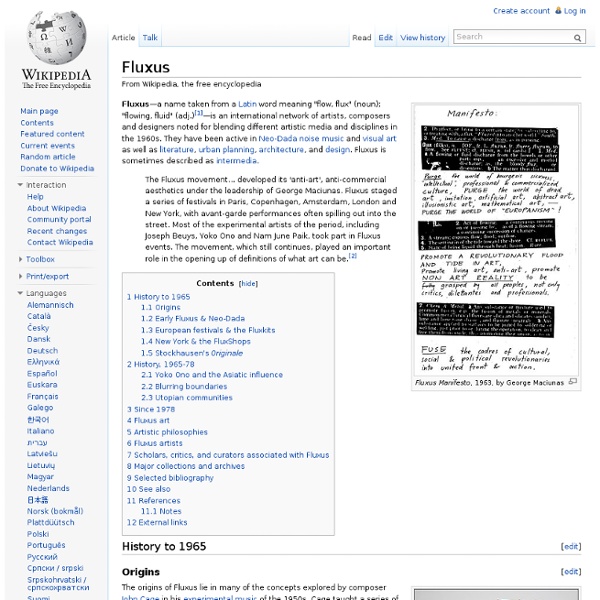Google
Fluxus Movement, Artists and Major Works | The Art Story
"In Fluxus there has never been any attempt to agree on aims or methods; individuals with something unnamable in common have simply naturally coalesced to publish and perform their work. Perhaps this common thing is a feeling that the bounds of art are much wider than they have conventionally seemed, or that art and certain long established bounds are no longer very useful." Synopsis Fluxus was a loosely organized group of artists that spanned the globe, but had an especially strong presence in New York City. George Maciunas is historically considered the primary founder and organizer of the movement, who described Fluxus as, "a fusion of Spike Jones, gags, games, Vaudeville, Cage and Duchamp." Key Ideas Unlike previous artistic movements, Fluxus sought to change the history of the world, not just the history of art. Fluxus art involved the viewer, relying on the element of chance to shape the ultimate outcome of the piece. Most Important Art Beginnings Concepts and Styles Fluxus and Zen
Elevator to the Gallows (1958
Noise music
Tellus13 Noise music is a term used to describe varieties of avant-garde music and sound art that may use elements such as cacophony, dissonance, atonality, noise, indeterminacy, and repetition in their realization. Noise music can feature distortion, various types of acoustically or electronically generated noise, randomly produced electronic signals, and non-traditional musical instruments. Noise music may also incorporate manipulated recordings, static, hiss and hum, feedback, live machine sounds, custom noise software, circuit bent instruments, and non-musical vocal elements that push noise towards the ecstatic.[1] The Futurist art movement was important for the development of the noise aesthetic, as was the Dada art movement, and later the Surrealist and Fluxus art movements, specifically the Fluxus artists Joe Jones and Takehisa Kosugi.[2] During the early 1900s a number of art music practitioners began exploring atonality.
Brassed Off
Brassed Off is a 1996 British comedy-drama film written and directed by Mark Herman and starring Pete Postlethwaite, Tara Fitzgerald and Ewan McGregor. The film, a British-American co-production made between the Monty Python production company Prominent Features, Channel Four Films and Miramax Films, is about the troubles faced by a colliery brass band, following the closure of their pit. The soundtrack for the film was provided by the Grimethorpe Colliery Band, and the plot is based on Grimethorpe's own struggles against pit closures. It is generally very positively received for its role in promoting brass bands and their music. Parts of the film make reference to the huge increase in suicides that resulted from the end of the coal industry in Britain, and the struggle to retain hope in the circumstances. Audio samples from the film were used on the famous 1997 Chumbawamba record, Tubthumper. Background[edit] Plot[edit] Cast[edit] Soundtrack[edit] Track listing[edit] In popular culture[edit]
In Search of Lost Art: Kurt Schwitters’s Merzbau
Kurt Schwitters. Picture with Light Center. 1919. Cut-and-pasted colored paper and printed paper, watercolor, oil, and pencil on board. Purchase. © 2012 Artists Rights Society (ARS), New York/VG Bild-Kunst, Bonn It was a gray, humid day in Hannover, Germany, and I was on a mission: to experience the Merzbau, a room-sized, living sculptural construction by artist Kurt Schwitters. But how do you experience something that doesn’t exist? Kurt Schwitters was an early 20th-century Dada artist whose elegant collages are a touchstone of MoMA’s collection. Schwitters’ art was more than just the collage object itself. The Hannover Merzbau by Kurt Schwitters. Schwitters worked on the Hanover Merzbau from around 1923 until 1937, when he fled to Norway to escape the threat of Nazi Germany. One way is through photographs from the time. But these photographs only capture what the Merzbau looked like in one particular instant. The Sprengel Museum in Hannover.
Ernst Lubitsch
Ernst Lubitsch (January 29, 1892 – November 30, 1947)[1] was a German American[2] actor, screenwriter, producer and film director. His urbane comedies of manners gave him the reputation of being Hollywood's most elegant and sophisticated director; as his prestige grew, his films were promoted as having "the Lubitsch touch." In 1947 he received an Honorary Academy Award for his distinguished contributions to the art of the motion picture, and he was nominated three times for Best Director. Life and career[edit] Lubitsch was born in Berlin, Germany, the son of Anna (née Lindenstaedt) and Simon Lubitsch (Russian: Любич), a tailor. Lubitsch, c. 1920 Weimar years (1918–1922)[edit] With glowing reviews under his belt, and American money flowing his way, Lubitsch formed his own production company and set to work on the high-budget spectacular The Loves of Pharaoh (1921). Career in Hollywood[edit] Writing about Lubitsch's work, critic Michael Wilmington observed: Later career[edit] Filmography[edit]
Boring Formless Nonsense
Boring Formless Nonsense intervenes in an aesthetics of failure that has largely been delimited by the visual arts and its avant-garde legacies. It focuses on contemporary experimental composition in which failure rubs shoulders with the categories of chance, noise, and obscurity. In these works we hear failure anew. We hear boredom, formlessness, and nonsense in a way that gives new purchase to aesthetic, philosophical, and ethical questions that falter in their negative capability. Reshaping debates on failure as an aesthetic category, eldritch Priest shows failure to be a highly dubious concept.



